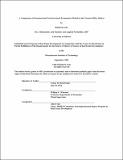| dc.contributor.advisor | William C. Wheaton. | en_US |
| dc.contributor.author | Gole, Kimberly | en_US |
| dc.contributor.other | Massachusetts Institute of Technology. Center for Real Estate. Program in Real Estate Development. | en_US |
| dc.coverage.spatial | n-cn-on | en_US |
| dc.date.accessioned | 2015-01-05T19:35:43Z | |
| dc.date.available | 2015-01-05T19:35:43Z | |
| dc.date.copyright | 2014 | en_US |
| dc.date.issued | 2014 | en_US |
| dc.identifier.uri | http://hdl.handle.net/1721.1/92607 | |
| dc.description | Thesis: S.M. in Real Estate Development, Massachusetts Institute of Technology, Program in Real Estate Development in conjunction with the Center for Real Estate, 2014. | en_US |
| dc.description | This electronic version was submitted by the student author. The certified thesis is available in the Institute Archives and Special Collections. | en_US |
| dc.description | Cataloged from student-submitted PDF version of thesis. | en_US |
| dc.description | Includes bibliographical references (pages 48-49). | en_US |
| dc.description.abstract | This thesis aims to compare five systems of econometric equations to describe the Toronto office market. It compares four structural systems differing in their demand equations and a non-structural system that does not require predefined relationships to exist between variables. Within the structural system of equations the predefined equations require that real rent is estimated solely from vacancy, long-run supply is dependent upon real rent and changes in employment only affect demand. Demand can be estimated either directly by estimating occupied stock and obtaining vacancy through an identity or by estimating vacancy; both occupied stock and vacancy can either be estimated in levels or estimated by an error correction model. Through the analysis of the structural models it is found that real rent shows significant momentum of real rent one year previous. As well the long-run supply curve is rising, while the real rent curve is not rising through the analysis period, as such the long-run supply is estimated in differences as the theoretical relationship between real rent and long run supply in levels cannot be estimated with the correct sign for the Toronto market. The structural demand equations show that error correction terms add value to predictions of demand. The nonstructural model is defined as a vector autoregressive model and allows the variables to freely interact between themselves without the restrictions placed in the structural model. When comparing the structural systems to the non-structural system in the back test, the non-structural system produces superior estimates in the system as a whole. The superior results of the VAR agree with the notion that in complicated dynamic systems by placing restrictions on the interactions of the variables poorer forecasts may result. | en_US |
| dc.description.statementofresponsibility | by Kimberly Gole. | en_US |
| dc.format.extent | 70 pages | en_US |
| dc.language.iso | eng | en_US |
| dc.publisher | Massachusetts Institute of Technology | en_US |
| dc.rights | M.I.T. theses are protected by copyright. They may be viewed from this source for any purpose, but reproduction or distribution in any format is prohibited without written permission. See provided URL for inquiries about permission. | en_US |
| dc.rights.uri | http://dspace.mit.edu/handle/1721.1/7582 | en_US |
| dc.subject | Center for Real Estate. Program in Real Estate Development. | en_US |
| dc.title | A comparison of structural and non-structural econometric models in the Toronto office market | en_US |
| dc.type | Thesis | en_US |
| dc.description.degree | S.M. in Real Estate Development | en_US |
| dc.contributor.department | Massachusetts Institute of Technology. Center for Real Estate. Program in Real Estate Development. | en_US |
| dc.contributor.department | Massachusetts Institute of Technology. Center for Real Estate | |
| dc.identifier.oclc | 898189419 | en_US |
